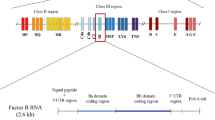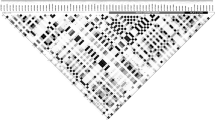Abstract
Recently a number of promoter alleles of interleukin-10 (IL-10) have been described in humans that affect the progression of HIV-1. Since infection of different species of monkeys with HIV-1, HIV-2 and SIV result in a widely varying outcome of the disease, we sought to study the nature of IL-10 promoter mutations in three different species of monkeys, namely rhesus, baboon and marmoset. We have identified three novel types of polymorphisms in monkeys that are characterized by insertions, deletions and substitutions besides several single nucleotide polymorphisms. Most interesting results were obtained with rhesus monkeys that lacked the 10-base long deletion in the polymorphic region B and the 12-base substitution in the polymorphic region C identified in marmoset monkeys. It is obvious that mutations of this nature involving insertions, deletions or substitutions of large sequences may potentially change the structure of the chromosome that are likely to affect binding of various transcription factors and consequently levels of transcription. The promoter region studied is highly polymorphic when compared to humans and at several places the changes are unique for a particular species of monkey. These observations may directly impact upon the progression of HIV-1 disease including other diseases/disorders where IL-10 levels have been implicated.
This is a preview of subscription content, access via your institution
Access options
Subscribe to this journal
Receive 6 digital issues and online access to articles
$119.00 per year
only $19.83 per issue
Buy this article
- Purchase on Springer Link
- Instant access to full article PDF
Prices may be subject to local taxes which are calculated during checkout
Similar content being viewed by others
References
Shin HD, Winkler C, Stephens JC et al Genetic restriction of HIV-1 pathogenesis to AIDS by promoter alleles of IL10 Proc Natl Acad Sci USA 2000 97 14467–14472
Kollmann TR, Pettoello-Mantovani M, Katopodis NF et al Inhibition of acute in vivo human immunodeficiency virus infection by human interleukin 10 treatment of SCID mice implanted with human fetal thymus and liver Proc Natl Acad Sci USA 1996 93 3126–3131
Badou A, Bennasser Y, Moreau M et al Tat protein of human immunodeficiency virus type 1 induces interleukin-10 in human peripheral blood monocytes: implications of protein kinase C-dependent pathway J Virol 2000 74 10551–10562
Patarca R, Sandler D, Maher K et al Immunological correlates of disease severity in pediatric slow progressors with human immunodeficiency virus type 1 infection AIDS Res Hum Retroviruses 1996 12 1063–1068
Houle M, Thivierge M, Gouill CL et al IL-10 up-regulates CCR5 gene expression in human monocytes Inflammation 1999 23 241–251
Husman A-MR, Blaak H, Brouwer M et al CC chemokine receptor 5 cell surface expression in relation to CC chemokine receptor 5 genotype and the clinical course of HIV-1 infection J Immunol 1999 163 4597–4603
Eskdale J, Keijsers V, Huizinga T et al Microsatellite alleles and single nucleotide polymorphisms (SNP) combine to form four major haplotype families at the human interleukin-10 (IL-10) locus Genes Immun 1999 2 151–155
Koss K, Fanning GC, Welsh KI et al Interleukin-10 gene promoter polymorphism in English and Polish healthy controls. Polymerase chain reaction haplotyping using 3′ mismatches in forward and reverse primers Genes Immun 2000 1 321–324
Howell WM, Turner SJ, Bateman AC et al IL-10 promoter polymorphisms influence tumour development in cutaneous malignant melanoma Genes Immun 2001 2 25–31
Kube D, Laser H, Knethen AV et al The AT-rich region between −54 to −66 is important for the promoter activity of interleukin-10 in Epstein-Barr virus positive Burkitt’s lymphoma cells Genes Immun 1999 1 105–114
Edinger AL, Clements EJ, Doms RW et al Chemokine and orphan receptors in HIV-2 and SIV tropism and pathogenesis Virology 1999 260 211–221
Ramamoorti N, Banerjea AC Novel SDF-1 gene mutations in simians: presence of GG–AA transition in the 3′ untranslated region AIDS 2000 14 1279–1281
Shanmugasundaram GK, Ramamoorti N, Banerjea AC Novel HIV co-receptor-CCR5 promoter mutations in simians: identification of two highly polymorphic regions with extensive deletions AIDS 2000 14 2201–2202
Kube D, Platzer C, Knethen AV et al Isolation of the human interleukin 10 promoter. Characterization of the promoter activity in Burkitt’s lymphoma cell lines Cytokine 1995 7 1–7
Kim JM, Brannan CI, Copeland NG et al Structure of the mouse IL-10 gene and chromosomal localization of the mouse and human genes J Immunol 1992 148 3618–3623
Author information
Authors and Affiliations
Corresponding author
Additional information
This work was supported by a grant from the Department of Biotechnology, Government of India, to the corresponding author (ACB) and to National Institute of Immunology, New Delhi, India.
Rights and permissions
About this article
Cite this article
Kumarvelu, J., Shanmugasundaram, G., Unwalla, H. et al. Genetic analyses of the promoter region of interleukin-10 gene in different species of monkeys: implications for HIV/AIDS progression. Genes Immun 2, 404–407 (2001). https://doi.org/10.1038/sj.gene.6363799
Received:
Revised:
Accepted:
Published:
Issue Date:
DOI: https://doi.org/10.1038/sj.gene.6363799



